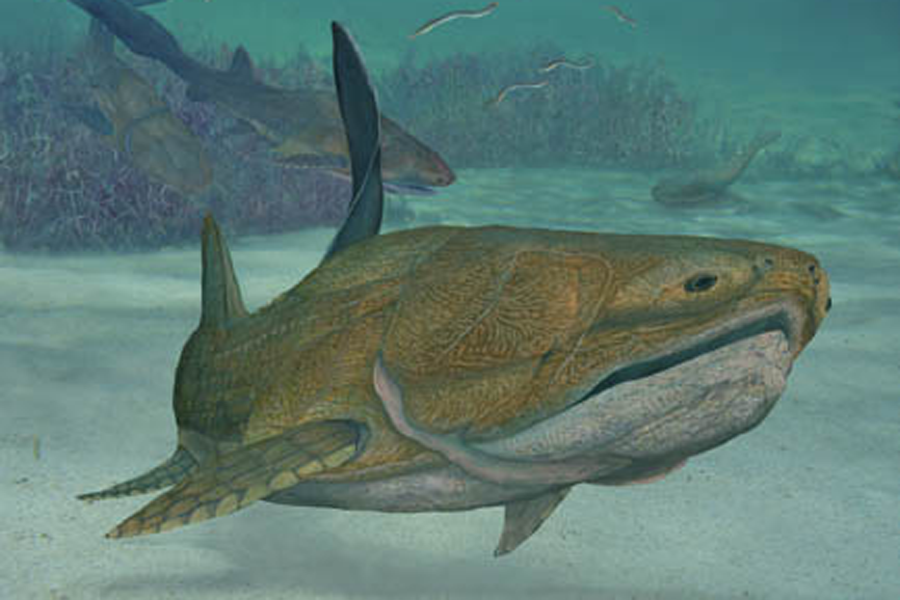The first fish face? Fossil sports modern jaw and facial bones.
Loading...
The next time you and a child make fish faces at each other, take a moment to appreciate Entelognathus primordialis's contribution to the giggles.
Paleontologists working in China have uncovered 419-million-year-old fossil remains of a fish they've dubbed E. primordialis, which sports the earliest known structures comparable to the modern jaw and facial bones in today's vertebrates, including humans.
The discovery "really is significant in helping to clarify this weird transformation – the evolution of faces," says Thomas Holtz Jr., a paleontologist at the University of Maryland at College Park.
A team led by Min Zhu, with the Chinese Academy of Sciences' Institute of Vertebrate Paleontology and Paleoanthropology in Beijing, uncovered the remarkable preserved fossil in rock formations at a reservoir in Yunnan Province.
The fossilized fish, roughly 8 inches long, is complete, with bones still joined. Its head and shoulders are covered with bony plates, in addition to sporting a bony skeleton.
Finding an intact fish of any sort from this geological period, known as the Silurian, is rare enough, researchers say. To find one with such important clues to the evolution of faces is remarkable. The facial structure E. primordialis displays is sufficiently advanced to suggest that the origins of jaws and other facial bones among vertebrates originate even deeper in geologic time.
It's like finding pieces of a spacecraft amid the wreckage of medieval horse-drawn carts, says Xaiobo Yu, a paleontologist at Kean University un Union, N.J., and a member of the team reporting its results in Thursday's issue of the journal Nature.
Back in E. primordialis's day, Earth was undergoing gradual but remarkable changes. The south polar supercontinent Pangea was breaking up. What is now North America was isolated, wandering north as plate tectonics reshuffled the planet's land masses. Asia, and China in particular, were clusters of smaller land masses.
Biologically, Earth was recovering from two back-to-back extinctions between 450 and 440 million years ago. The period prior to the die-offs saw enormous diversification of invertebrates, shell fish, and jawless fish. With the extinction events, researchers estimate that the planet lost 60 percent of all marine invertebrates.
On land, primitive plants – mainly mosses – clustered along coastlines or around lakes while continental interiors essentially were deserts. Land creatures consisted of bugs and temporary interlopes, such as horseshoe crabs, which mate and lay eggs on land.
During the recovery, fish began to evolve jaws, teeth, and now faces. Through the Silurian and its follow-on, the Devonian period, species emerged with some or all of these features in every possible combination, Holtz explains. By the end of the Devonian, fish began to sprout fingers and toes and spend some of their time on land.
Finding a modern-looking jaw and facial bones in a 419-million year old armored fish is forcing researchers to rethink the evolutionary path that faces took en route to modern bony fish and terrestrial vertebrates.
Today's jaw-bearing fish are divided into two broad groups – those, like sharks, whose skeletons are made largely from cartilage and whose hides host tiny, sharp cartilage scales, and those whose skeletons are bone and may also have bony plates armoring their heads and shoulders.
Up to now, the general view has held that the common ancestor to the more-recent bony fish and land vertebrates, including humans, on the one hand, and to sharks and their relatives on the other, was shark-like, Dr. Yu says. That implied that sharks are more primitive than bony fish, whose additional facial bones were seen as newer in evolutionary terms.
The discovery of modern-looking structures in E. primordialis flips that picture, pointing to this bony, armored fish as a common ancestor to the lineage that would split into bony fish and the cartilaginous sharks.
If this interpretation holds up to further scrutiny, it would signal sharks are less primitive than previously thought and would prompt questions about the evolutionary pressures that would prompt the sharks' line to shed its armor and bone for an abrasive hide and cartilage.








